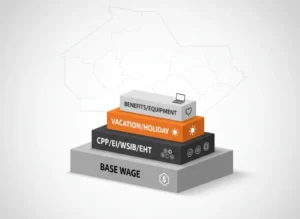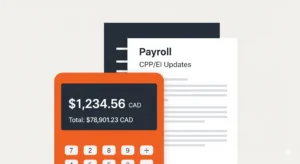As of today, October 1, 2025, a significant payroll change has taken effect for every business in the province. The general minimum wage in Ontario has officially increased from $17.20 to $17.60 per hour. This planned adjustment impacts over 800,000 workers and requires immediate attention from employers to ensure compliance and smooth payroll processing.
For business owners and HR managers, this is more than just a 40-cent adjustment. It’s a critical compliance update that affects your payroll, budgets, and employee compensation strategies. Staying ahead of these changes is key to maintaining a fair and legally sound workplace.
The New 2025 Minimum Wage Rates in Ontario
While the general rate is the most talked-about figure, the Employment Standards Act, 2000 (ESA) also outlines specific rates for different classes of employees. It is crucial to apply these correctly.
As of October 1, 2025, the new rates are:
- General Minimum Wage:$17.60 per hour
This is the standard rate that applies to most adult employees. - Student Minimum Wage:$16.60 per hour
This applies to students under 18 who work 28 hours a week or less when school is in session, or work during a school break or summer holidays. - Homeworkers’ Minimum Wage:$19.35 per hour
This rate is for employees who do paid work in their own homes for an employer (e.g., sewing, data entry, call centre work). - Hunting, Fishing & Wilderness Guides Rates:
- $88.05 for working less than five consecutive hours in a day.
- $176.15 for working five or more hours in a day.
It’s important to note that the separate, lower minimum wage for liquor servers was eliminated in 2022. Bartenders and alcohol servers are now entitled to the general minimum wage of $17.60 per hour.
Why the Ontario Minimum Wage Increase Happened
This increase is not an arbitrary decision. Under the ESA, Ontario’s minimum wage rates are tied to the Ontario Consumer Price Index (CPI), a key measure of inflation. The government announced this 2.4% increase back in April 2025 to provide businesses with six months of predictability to plan for the change.
This policy aims to make annual increases more stable and ensures that wages keep pace with the rising cost of living, helping workers and their families manage expenses.
“At a time when many families are feeling the pressure of global economic uncertainty, our government will protect Ontario workers with a minimum wage increase that supports our world-class workforce,” said David Piccini, Minister of Labour, Immigration, Training and Skills Development.
By linking the rate to the CPI, the process is removed from political debate, creating a more predictable economic environment for both employers and employees. For a full-time employee working 40 hours a week, this increase translates to an annual pay raise of over $800.
Beyond the Hourly Rate: Broader Impacts on Your Business
Simply updating the hourly rate in your payroll software is just the first step. A change to the minimum wage has ripple effects across your financial and HR processes that you need to consider.
Recalculating Other Forms of Pay
Several other types of mandatory pay are calculated based on an employee’s regular wage. This means you must review and potentially adjust:
- Overtime Pay: This must be calculated at 1.5 times the new, higher minimum wage (or the employee’s regular rate, if greater).
- Public Holiday Pay: The calculation for this is based on the total regular wages earned in the pay period before the holiday, which will now be higher for minimum wage earners.
- Vacation Pay: As wages increase, the corresponding 4% or 6% vacation pay accrual will also increase.
Reviewing Salary and Commission Structures
This change doesn’t just impact hourly workers. If you have salaried or commission-based employees, you must ensure their total earnings, when divided by the total hours worked, meet or exceed the new minimum wage for every pay period. This is a common compliance oversight that can lead to significant penalties.
What Ontario Employers Should Do Next
Proactive adjustments are crucial for a smooth transition. Here are three immediate action items to ensure your business is fully compliant with the Ontario minimum wage increase.
- Update Your Payroll System Immediately. This is the most critical step. Verify that your payroll software, internal spreadsheets, and any third-party payroll providers have updated all relevant wage rates effective October 1, 2025. Double-check the rates for students and homeworkers if they apply to your business.
- Communicate the Change with Your Team. Transparency is key. Inform all affected employees in writing (via email or a memo) that their wage rate has been updated in compliance with provincial law. This proactive communication builds trust and prevents confusion when they receive their next pay stub. Frame it as a positive, legally-mandated update.
- Review and Adjust Your Budget. This wage increase will directly impact your labour costs. Review your financial forecasts for the remainder of the year and into 2026. This may require you to re-evaluate staffing levels, pricing for your products or services, or other operational expenses to accommodate the higher payroll.
Navigating changes to the Employment Standards Act can be complex. Taking these immediate, practical steps will ensure you remain a compliant and fair employer.
Need help navigating HR changes? Book your free HR audit today or speak with our team about how Divino can support your business.
Sources
- Ontario.ca. (2025). Ontario Raising Minimum Wage to Protect Workers. https://news.ontario.ca/en/release/1006550/ontario-raising-minimum-wage-to-protect-workers
- Monkhouse Law. (2025). Minimum Wage Ontario 2025 – All Rates Increasing October 1, 2025. https://www.monkhouselaw.com/minimum-wage-ontario/
- Peninsula Canada. (2025). Ontario Minimum Wage 2025: New Rates and Employer Guide. https://www.peninsulacanada.ca/resource-hub/minimum-wage/minimum-wage-increase-in-ontario/




